 Johanna Fateman
Johanna Fateman
The artist’s new installation welcomes a submersion into
spatial experience.
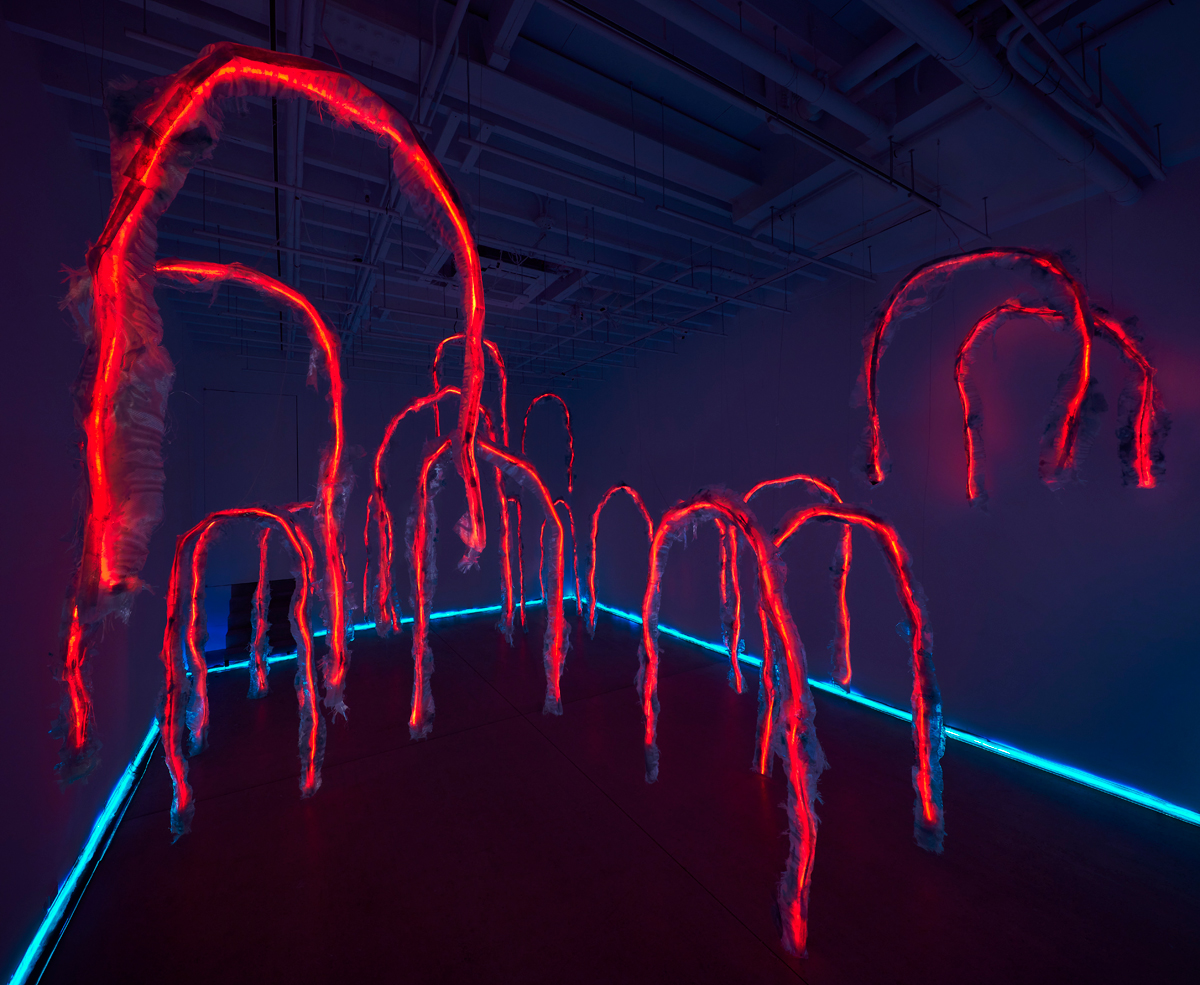
Tiril Hasselknippe: Hyperstate, installation view. Courtesy Magenta Plains. Photo: John Muggenborg. © John Muggenborg.
Tiril Hasselknippe: Hyperstate, Magenta Plains, 149 Canal Street, New York City, through February 24, 2024
• • •
In the dark gallery, a scattered architecture or a disintegrated maze of glowing doors seems to float, like spectral ruins in an abstract virtual-reality scene. There’s no video involved in this eerie suggestion of a player-activated narrative, though. Tiril Hasselknippe, for Hyperstate, her new installation in the basement of Magenta Plains, has suspended a simple, repeated form—nearly twenty upside-down, irregular U-shapes, made from bent rods or tubes containing red luminescent dye—at various heights for visitors to pass through or beneath. They look almost hand-drawn, in Day-Glo chalk maybe, or like giant worms, their unsteady silhouettes thickened and blurred by a tattered tissuey outer layer. Accompanying the static sculptural arrangement is a sound piece, a spare composition of otherworldly wind, wavering chimes, and the kind of shivering, metallic glissando that might announce the arrival of a spirit or an alien. Here—in this haunted setting, dimly lit by arches—it suggests the opening of portals, the uncovering of hidden passageways.
In keeping with the artist’s economical, low-tech evocation of dystopian sci-fi tropes, the synth-ish noise was produced with a waterphone (sometimes called an ocean harp), an acoustic instrument often used in horror film scores. But, interestingly, Hasselknippe’s reference to the sonic clichés of jump-scare tension, her looping of poltergeist-spaceship effects never accelerates or approaches crescendo; any anxiety it initially provokes quickly fades. During my visit, I had no dreadful sense that something was about to happen, that time was running out, or that I was supposed to find—as in a video game—a key to reach the next level. Instead, cued by Hyperstate’s structural invitation, I explored the fragmented puzzle without urgency or identifiable aim. I walked through it via different routes at different speeds, crossing each illuminated threshold, covering every square inch of the room. If the show delivers drama at first sight, with the floating arches’ smoldering outlines emerging from cold cosmic black, Hyperstate’s spatial choreography ultimately undercuts its illusionistic gestures, fostering an awareness of the gallery’s four walls, its floor, the hard limits of the space.
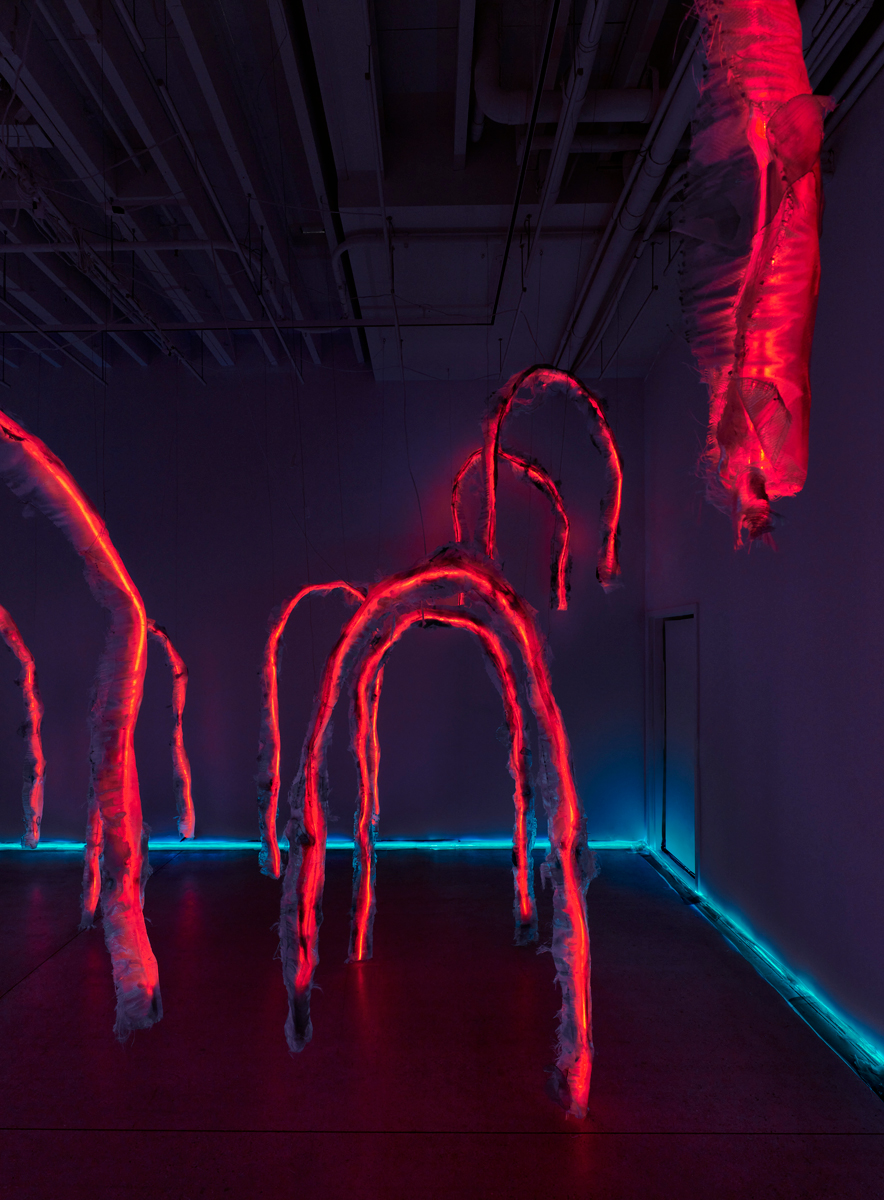
Tiril Hasselknippe: Hyperstate, installation view. Courtesy Magenta Plains. Photo: John Muggenborg. © John Muggenborg.
The term immersive, with regard to art (historically abused in publicity materials to describe works that are imposing in some way but not truly enveloping or environmental), has been mostly abandoned, I think, surrendered to a certain strain of transporting, transfixing, large-scale, digital spectacle. But I keep coming back to it. While Hasselknippe’s engagement is distinct from that genre’s goal of awe and entrancement, and her installation’s true thrills turn out to be rather subtle, there might be no better descriptor for the work. When my eyes adjusted to the gloom, I was reminded less of an Infinity Room by Yayoi Kusama than of installation designs for Surrealist exhibitions by Marcel Duchamp—in which artworks were displayed in the shadows to be discovered with flashlights, or paths and views of paintings were obstructed by expanses of tangled twine. Hyperstate does sort of submerge you in a watery aural atmosphere—that contributes to the impression—but it also achieves a rare kind of viewer engagement, a conscious immersion, that’s about feeling the art as a container for experience rather than a vehicle for getting lost.
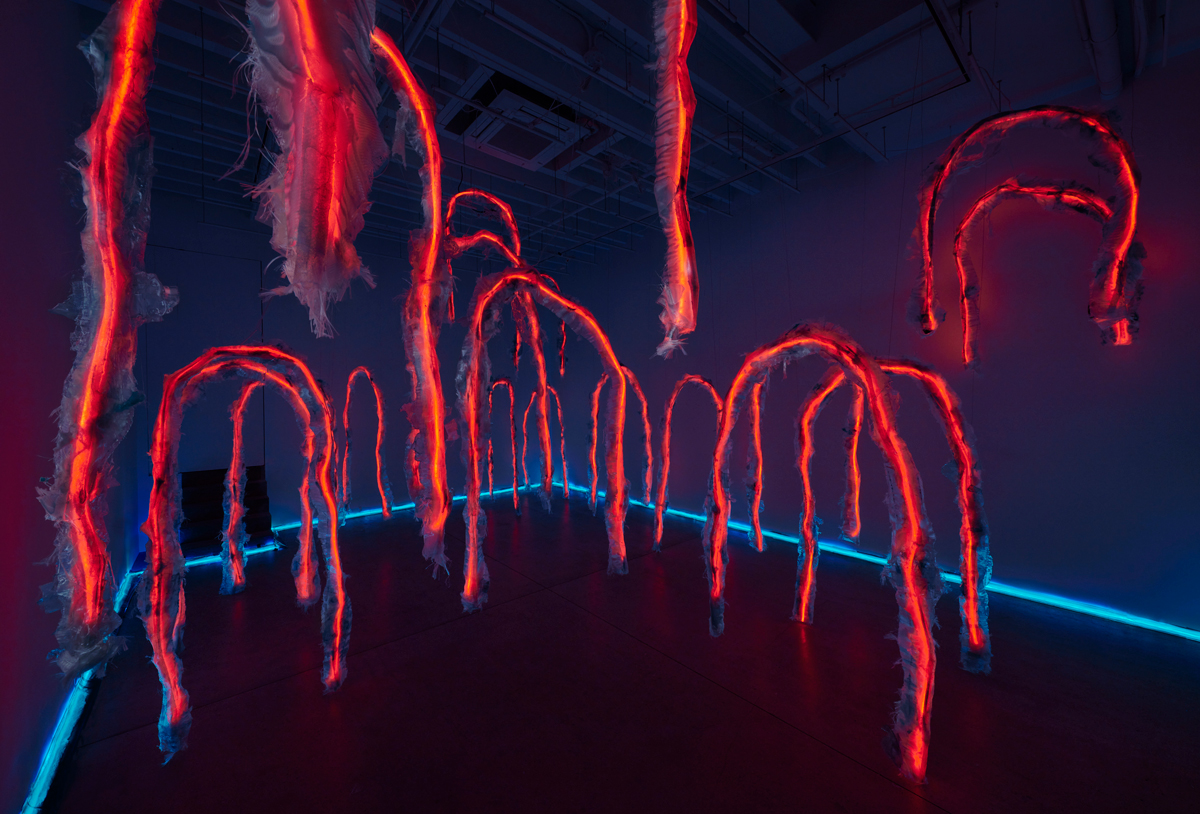
Tiril Hasselknippe: Hyperstate, installation view. Courtesy Magenta Plains. Photo: John Muggenborg. © John Muggenborg.
Hasselknippe, who is from Norway, has used the motif of the arch before: her exhibition Play at Kunsthalle Stavanger last year was a similar installation, but larger, and blue instead of red. For her last solo show in New York, in 2020, she focused on other ancient architectural forms, presenting a compact, welded-steel labyrinth and, in another room, a group of elfin-Doric, rough-hewn, weathered-looking concrete columns, resembling archaeological relics of a future civilization. They were, in fact, pedestals for basins containing such things as coal, crabs, and moss—potential elements of a water purification system—forming a tentative or partial image of survival. It’s a symbolic representation of post-apocalyptic life. Hyperstate, in contrast, seems to reflect the viscous, vulnerable realities of the physical self now, during our present mass-extinction event.
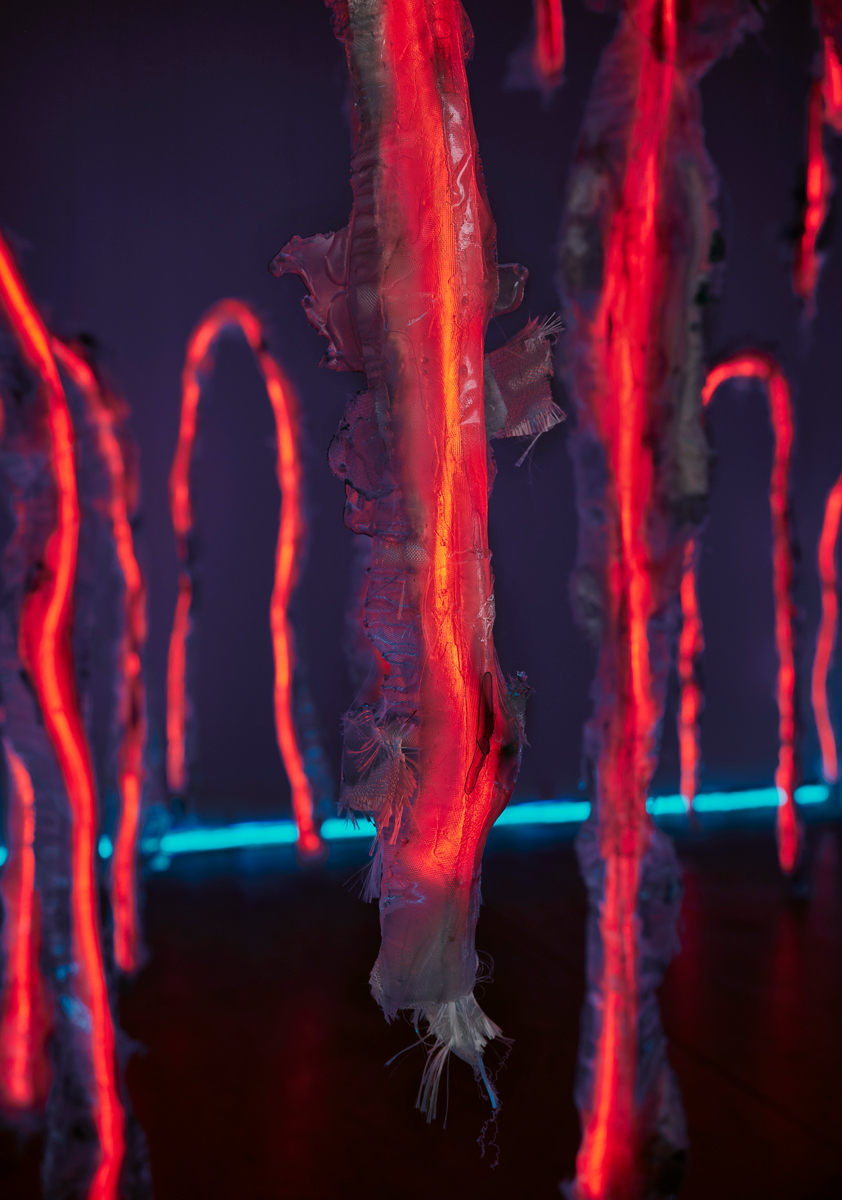
Tiril Hasselknippe: Hyperstate, installation view. Courtesy Magenta Plains. Photo: John Muggenborg. © John Muggenborg.
Though virtual or holographic in look from even a short distance, viewed up close, individually, the arches’ corporeal references and ragged materiality become clear. In a different context—in a brightly lit space, without the waterphone’s etheric intrusions—the wrapped, handled appearance of the horseshoe shapes might more loudly echo formal, Post-Minimalist concerns; instead, the translucent, fraying fabric, stiffened by resin, that encases the red cores recalls bandages and flesh. The result is not gory, somehow: the glowing lines also resemble cell membranes as seen through fluorescence imaging, suggesting that Hasselknippe’s investment in these flayed or magnified effects derives not only from a desire to represent violence or destruction abstractly but also (or foremost) from a fascination with the bloody and galactic nature of an organism’s inner space.
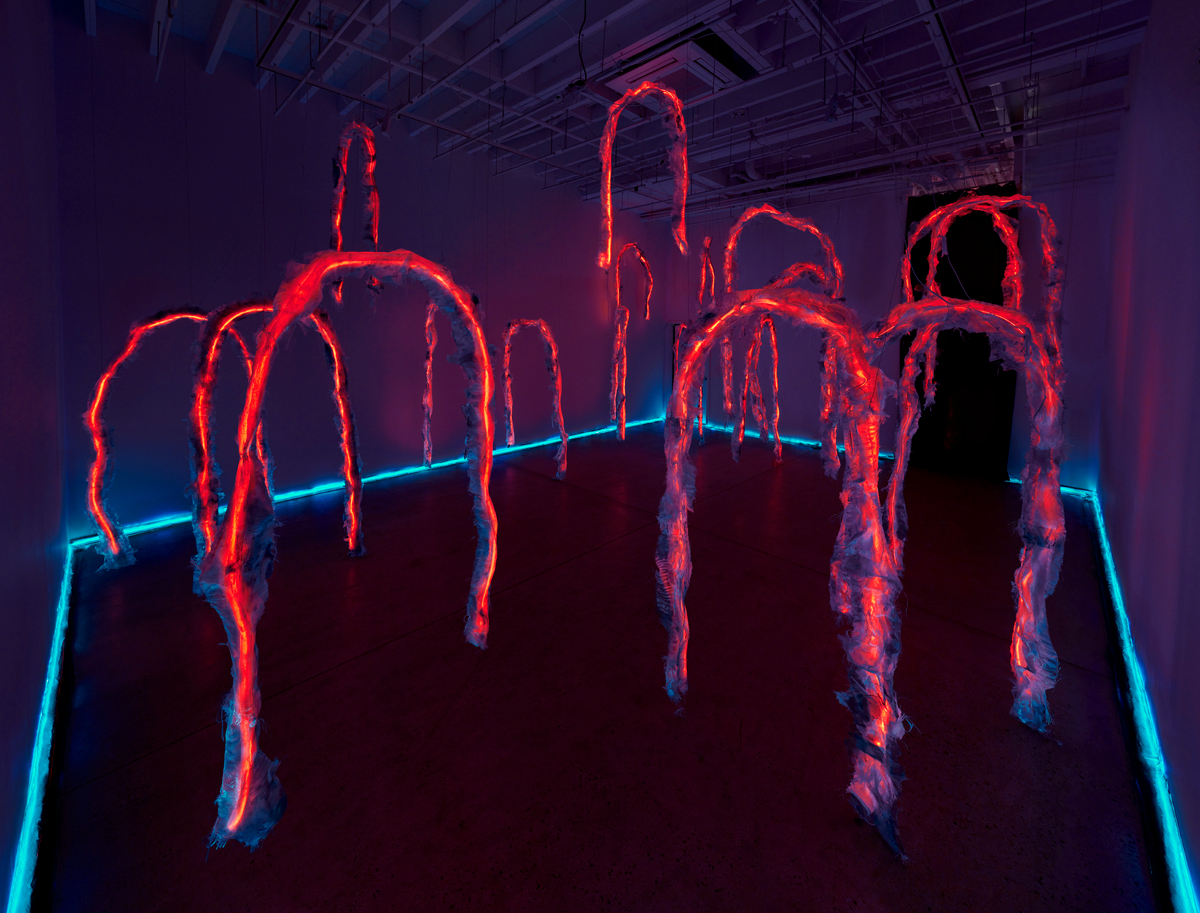
Tiril Hasselknippe: Hyperstate, installation view. Courtesy Magenta Plains. Photo: John Muggenborg. © John Muggenborg.
“At the end you hear the rush. It sounds like a river but it is your own body,” she writes in the impressionistic prose poem that serves as her press release, articulating in words the thin or porous veil between interior and exterior worlds that her installation can be seen to describe, with its shifting sense of scale; its evocation of both cinematic and microscopic vastness; its pairing of hallucinatory qualities and demystifying exposures of its mundane, material constraints. For the artist, whose experience of fibromyalgia—a disorder characterized by brain fog and widespread musculoskeletal pain—informs her work, a buckling built environment might serve as a particularly powerful metaphor. “Doctors tend to not believe me,” she (or her first-person narrator) explains. “I kept seeing the ground move when walking the concrete sidewalks. The lines kept distorting into shapes of rubble . . .” The ruminative, meandering text, though it lacks the precision of the show’s other components, underscores its themes with subtitles such as “Corridor,” “Science Fiction kept me ready,” and “Erroring,” while it establishes her installation as a scene or set for a story.
The plot may be a generic one of cataclysm that we all know, that always looms, that waits behind every door. Less familiar, more intriguing, is Hasselknippe’s balance of smoke-and-mirrors fantasy and deconstruction; her sophisticated convergence of obvious and obscure allusions in something as transient and elusive as ambience; the simple staging of an actually immersive work.
Johanna Fateman is a writer, art critic, and musician in New York.